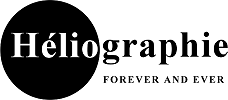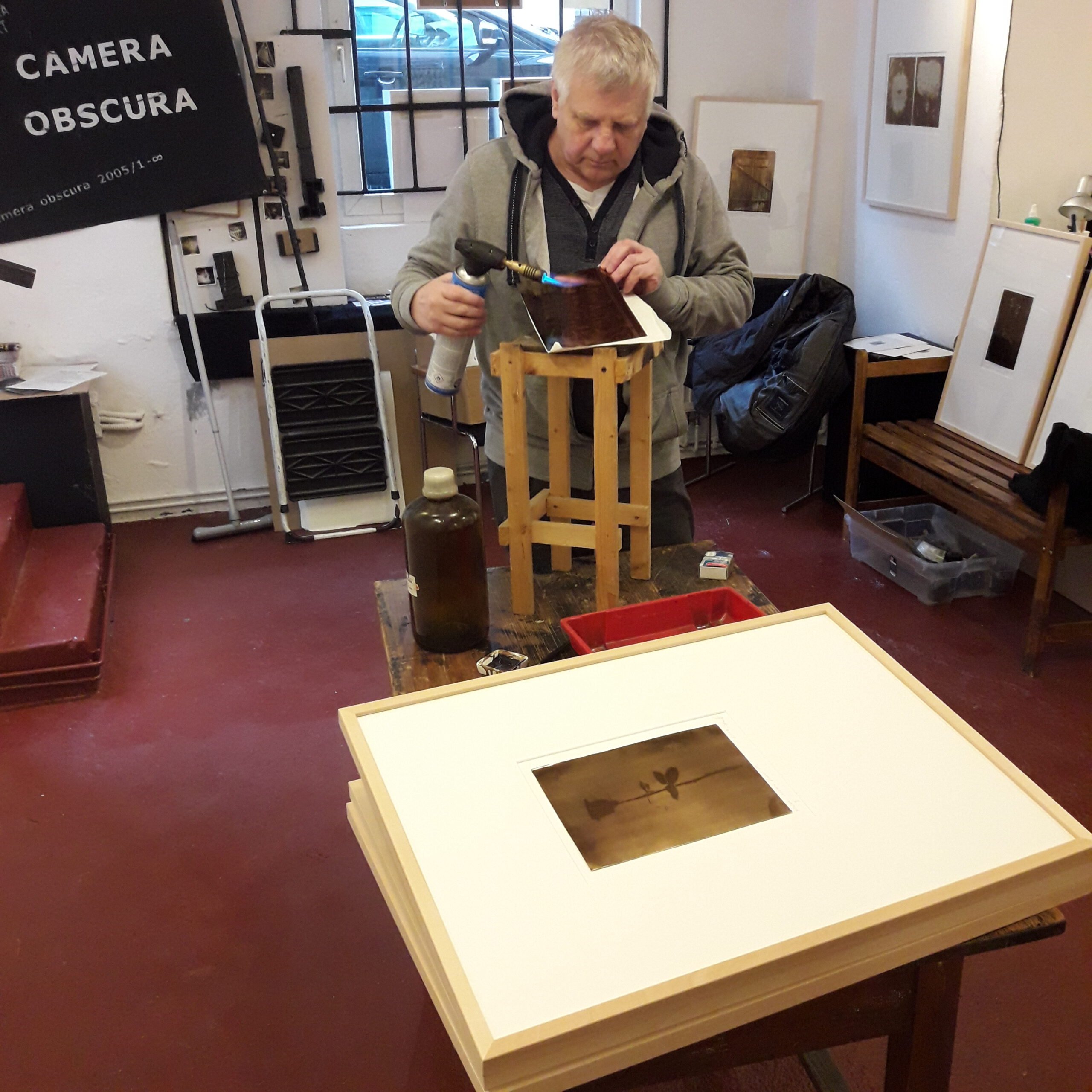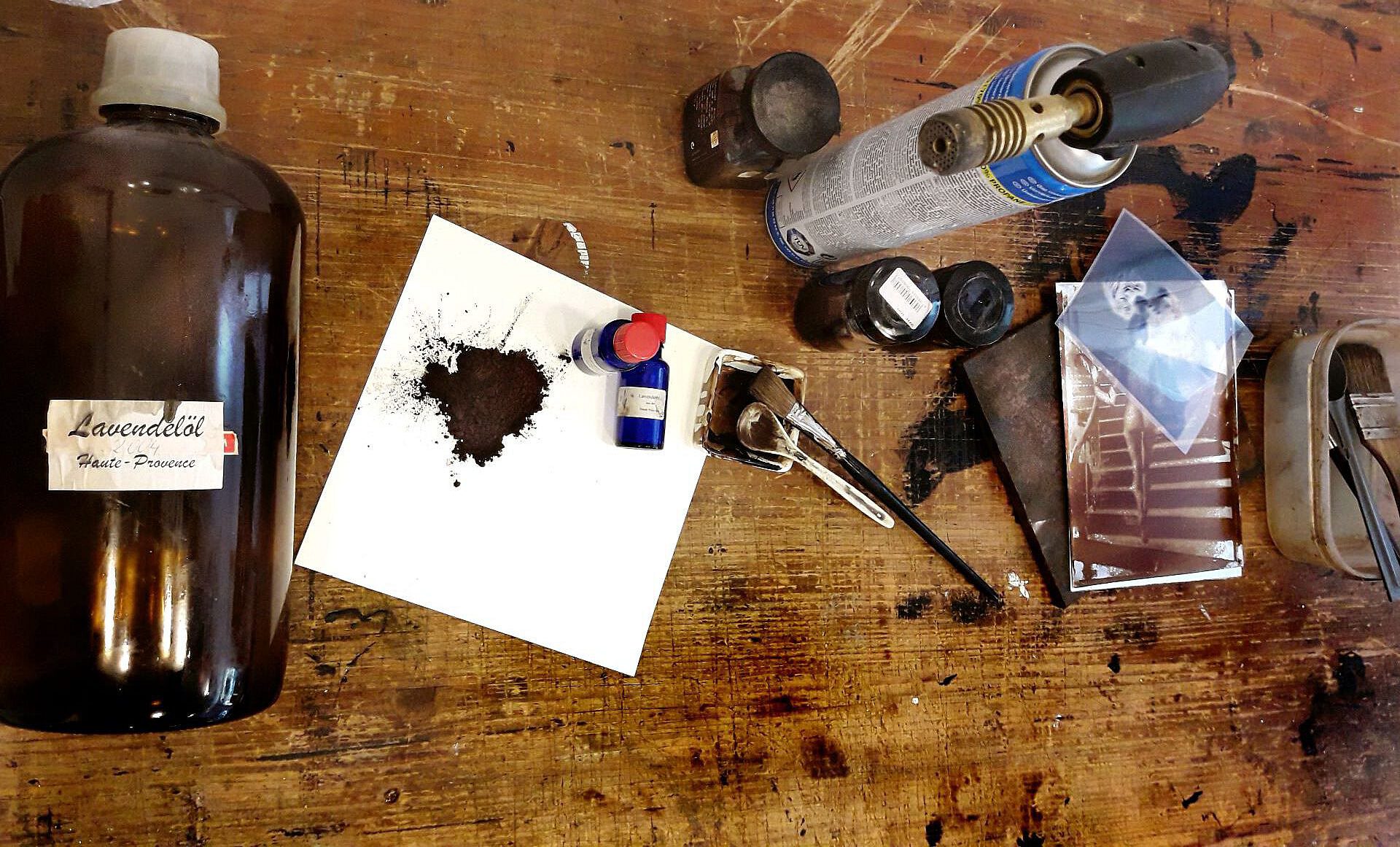Heliography Process
by Joseph Nicéphore Niépce,
1822 and 1827.
Niépce was originally looking for a process that would enable him to produce copies of copperplate prints. He succeeded in doing so in 1822 with an engraving of Cardinal Georges d’Amboise. Niépce coated a polished tin plate with a varnish of Syrian asphalt dissolved in lavender oil. On this tin plate coated in this way, he placed the copperplate (which had previously been made transparent with a varnish). He exposed the plate to sunlight for several hours.
However, this image is not considered the first photograph, as it was not taken with a camera obscura.
After further elaborate experiments, he then succeeded in taking the world’s first light-resistant photograph in Saint-Loup-de-Varennes in the early fall of 1827: a view from the window of his study in the Le Gras estate with an exposure time of several days and a format of 16.5 × 21 cm.
In his “Notice sur l’héliographie” written in 1829, Niépce describes these two processes for generating photographic images. Both image processes were summarized under the term “heliography”, which translated means “drawing with the sun”.
“On a late summer day in 1827, after several days of exposure, Joseph Nicéphore Niépce held the oldest photograph in his hands (which he himself called a heliography) which has survived to this day. The purely virtual, the previously incomprehensible became real, immortalized, and transportable on a tin plate coated with light-sensitive asphalt varnish”.
from the book “Camera Obscura Tübingen”, 2004 by Przemek Zajfert, Carsten Kauth and Wolfdietrich Müller with a foreword by Walter Jens
Above:
View of Mihaelas Garden taken in the period from June 13 to 22, 2023.
Heliography made with a camera obscura according to the method of Joseph Nicéphore Niépce from 1826. The exposure time was 8 sunny days.
Below:
Contact process by Joseph Nicéphore Niépce in 1822. Exposure time was about 1 sunny day.
On the trail of Joseph Nicéphore Niépce, the inventor of photography
with Martin Hein, March 2015 Joseph Nicéphore Niépce – * 7 March 1765 in Chalon-sur-Saône, France; † 5 July 1833 in Saint-Loup-de-Varennes. Niépce, who had a sister and two brothers, was an officer in the French army from 1789 to 1811; he administered the district of Nice between 1795 and 1801, and devoted himself to mechanical and chemical work as well as lithography with his brother Claude Niepce in his father’s town from 1815. From 1816, Niépce was engaged in the production of images with a Camera Obscura. “To reproduce the images taken by the camera obscura with the gradations of tones from black to white by the action of light itself” from the “Notice sur l’Héliographie, 1829. For his first experiments, he positioned sheets of paper coated with silver salts on the back of a camera obscura. It was known that silver salts (silver chloride) darken when exposed to light. In May 1816, he produced the first picture of nature: a view from the window. It was a negative and the image was not durable. After opening the camera, the exposure process continued, the image increasingly blackened and eventually disappeared completely. Niépce called this process “Retina”. The recording technique from the project “THE 7th DAY” is based on this process. Disappointed that there was no way to make this first photograph durable, Niépce turned his attention to other processes. In March 1817, Niépce focused his attention on guaiac resin. This yellow resin changes color to green when exposed to daylight. It is also sparingly soluble in alcohol. In principle, it could be used to make permanent photographs. However, this property of the resin is only caused by UV light. The glass lenses of his camera obscura largely filtered out this light and the guaiac resin did not change its properties in the camera. Contact prints in direct sunlight were possible, but unfortunately no photographs were taken with his camera obscura. Disappointed, Niépce turned to other substances, especially natural asphalt, also known as “Bitume de Judée”. The tough black-brown mineral was extracted from the Mine du Parc at that time, a mine near Seyssel, located about 100 kilometres from his country home in France. Finely powdered natural asphalt is dissolved in lavender oil and applied very thinly to metal plates (copper, tinplate), stone or glass. After drying on a hot iron plate, the coated material can be exposed. The exposure time for contact prints is several hours with sunlight. In a camera obscura the exposure takes several days. Depending on the amount of light, the asphalt hardens to different degrees. After exposure, the softer areas (where less light reached) can be washed out with a mixture of lavender oil and white oil. He describes his method in detail in his “Notice sur l’Héliographie”. Although the invention of photography can be dated to 1824 based on Niépce’s letters, the image that has survived to this day is from 1827. The images Niépce created in 1824 have disappeared, probably due to the reuse of the expensive materials of the time. On September 16, 1824, Nicéphore Niépce wrote to his brother Claude, who was living in England at the time: “I am pleased to finally inform you that, thanks to the refinement of my methods, I have succeeded in obtaining an image as I had hoped, though I hardly dared to expect it, as my results so far had been very incomplete. This view was taken from your room, which faces Le Gras; and for this purpose, I used my largest Camera Obscura and my largest plate. The image of the objects is reproduced with astonishing clarity and fidelity, down to the finest details and their subtlest shades. Since this negative print is almost uncolored, its effect can be best judged by viewing the plate at an angle: Then it becomes perceptible to the eye through the shadows and light reflections; and I must say, my dear friend, this effect really has something magical about it. (…) In the meantime, you can, as of today, consider the success of applying my methods to views, whether on stone or glass, as a proven and indisputable fact.” More: Auf den Spuren von Joseph Nicéphore NiépceView from the study of Le Gras (French title La cour du domaine du Gras “The courtyard of the estate of Le Gras” or Point de vue du Gras “View of Le Gras”) is the first successfully taken and preserved photograph in the world. It was produced in 1826 by Joseph Nicéphore Niépce in Saint-Loup-de Varennes, France.
Literature
- Helmut Gernsheim, «Vorstufen und frühe Entwicklungen», in Helmut Gernsheim (Hg.), Geschichte der Photographie. Die ersten hundert Jahre (Frankfurt a. M.: Prophyläen Verlag 1983), 11–41.
- Notice sur l´héliographique, 1829, Joseph Nicéphore Niépce, Bibliothèque nationale de France, département Estampes et photographie,.
- Blick aus dem Arbeitszimmer – Wikipedia
Related link
- Joseph Nicéphore Niépce, creator of the first photograph, Colin Harding, The National Science and Media Museum
- Harry Ransom Center, Introducing The Niépce Heliograph, Jessica S. McDonald
- Harry Ransom Center, The Niépce Heliograph
- https://photo-museum.org/
- Auf den Spuren von Joseph Nicéphore Niépce, dem Erfinder der Photographie – P. & P. Zajfert



